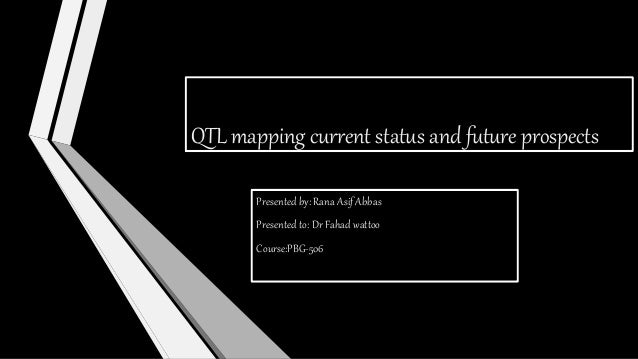
QTL mapping current status and future prospects
- 1. QTL mapping current status and future prospects Presented by: Rana Asif Abbas Presented to: Dr Fahad wattoo Course:PBG-506
- 2. Presentation content What is QTL What is QTL mapping Principles of QTL mapping Objectives of QTL mapping Methods to detect QTL Merits and demerits of QTL mapping Current status of QTL mapping Future prospects of QTL mapping
- 3. A quantitative trait locus (QTL) is a locus (section of DNA) that is related with variation of a quantitative trait in the phenotype of a population of organisms QTLs are genes whose phenotypic effects show a continuous range of variation in a population and is more or less normally distributed. A quantitative trait locus is the location of individual locus in the genome that affects a trait that is measured on linear scale What is QTL:
- 4. Locus: Fixed position on chromosome where a particular gene is located Linkage: Loci that are close enough together in the same chromosomes to deviate from independent assortment are said to display genetic linkage. What are quantitive traits: Many agricultural important traits such as yield, quality and some forms of disease resistance are controlled by many genes and are known as quantitative traits or complex traits. These traits show continues variation in population. These traits do not fall inti discrete classes and measured on linear scale.
- 5. What is QTL mapping: The process of constructing linkage maps and conducting QTL analysis to identify the genomic regions associated with traits is known as QTL mapping. Identification and location of complex traits is done by use of DNA markers. QTLs are mapped by identifying which molecular markers (such as SNPs or AFLPs) correlate with an observed trait. It involves testing DNA markers throughout the genome for the like hood that they are associated with QTL.
- 6. Principle of QTL mapping: Genes and markers segregate via chromosome recombination during meiosis thus allowing their analysis in the progeny. The detection of association between phenotype and genotype of markers. QTL analysis depends on the linkage disequilibrium. QTL analysis is usually undertaken in segregating mapping populations.
- 7. Objectives of QTL mapping: The basic objectives are to detect QTL, while minimizing the occurrence of false positives (Type 1 error, that is declaring an association between a marker and QTL when in fact one does not exist) To identify the region of the genome that affects the trait of interest. To analyze the effect of the QTL on the trait. How much of the variation for the trait is caused by a specific region? Which allele is associated with the favorable effect?
- 8. Methods to detect QTLs: Simple interval mapping Composite interval mapping Multiple interval mapping Bayesian interval mapping
- 9. Merits of QTL mapping: QTL mapping can help in Identification of novel genes Where mutant approaches fails to detect genes with phenotypic functions. Good alternative when mutant screening is laborious and expensive e.g. circadian rhythm screens Can identify new functional alleles of known functions genes QTL and Natural variation studies provide insight into the origin of plant evolutions.
- 10. Demerits of QTL mapping : Mainly identifies loci with large effects. Less strong one is hard to detect. Positions and effects of Number of QTL, s detected, are subjected to statistical error. Small additive effects/epistatic loci are not detected and may require further analysis.
- 11. Current status of QTL use: They help us in identification of many complex traits, their genes are identified and with further modification many issues solved. The abiotic stresses like drought, salinity, heat stress is identified with help of this mapping. Example: Mapping QTLS for salt tolerance in Rice by bulked segregate analysis of recombinant inbred lines.
- 12. QTL mapping of pearl millet rust resistance using an integrated DArT-and SSR- based linkage map QTL mapping for foxtail millet plant height in multi-environment using an ultra-high density bin map QTL mapping for 11 agronomic traits based on a genome-wide Bin-map in a large F2 population of foxtail millet QTL mapping for improvement of downy mildew resistance (DMR) in pearl millet Current research on QTL in millet
- 13. Future prospects: QTL studies have a rich history and have played an important role in gene cloning and characterization; however, there is still a great deal of work to be done. The existing data on model organisms needs to be expanded to the point at which meta- analysis is feasible in order to document strong trends regarding genetic architecture. Data generated by lab-based QTL studies can also be used to direct and inform other efforts, such as population genomics. The map between genotype and phenotype remains difficult to read, QTL analysis and a variety of associated innovations will likely to continue providing key landmarks. Constant improvements of molecular platforms. Advances in bioinformatics.